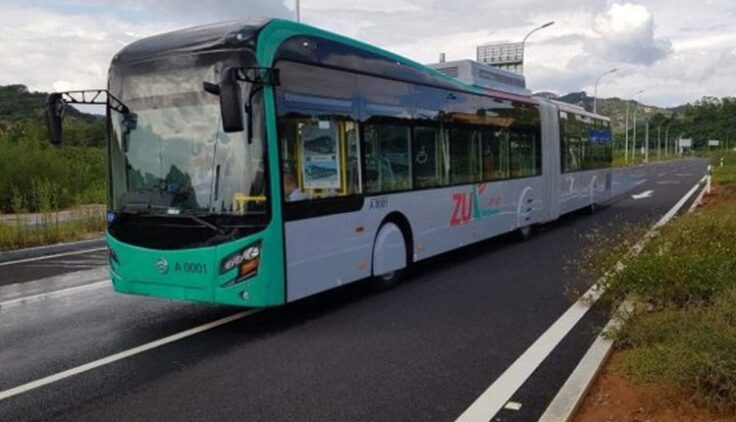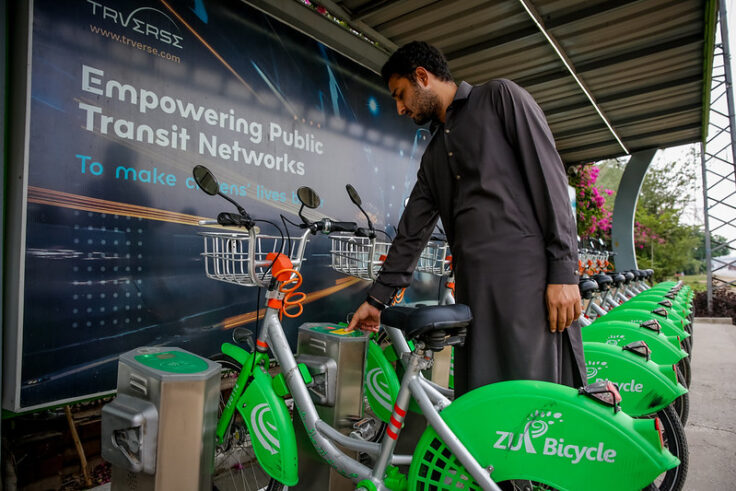May 10, 2024
Why Inclusive Transport Matters: In Conversation with TransPeshawar
Peshawar, Pakistan received Honorable Mentions in the Sustainable Transport Award program in both 2022 and 2024 for their approach to inclusive, people-centered transport. ITDP interviewed TransPeshawar to gather more in-depth insights into their work.

What are the primary features of Zu Peshawar that you think have made it particularly successful in terms of inclusion, diversity, and access?
Zu Peshawar has emerged as a successful model in terms of inclusion, diversity, and access because the system is tailored to address societal gaps. Since its inception in August 2020, it has revolutionized Peshawar’s transport landscape, replacing outdated and environmentally harmful vehicles with a modern third-generation BRT system. Prior to Zu Peshawar, the city’s public transport was marred by safety concerns, such as inaccessibility due to high-floored vehicles that marginalized individuals with disabilities and pervasive harassment that deterred women and transgender individuals. Such harassment resulted in a mere 2% female ridership previously. People with disabilities were also completely excluded from the system due to a lack of accessibility measures, and same was the case for the elderly and young children. On top of this, high fares acted as a barrier for low-income individuals, further excluding whole communities.
Since its inception, Zu Peshawar has continued to place a focus on the most vulnerable segments of the society. We started by providing separate seating spaces for women on buses, separate waiting areas on stations, and installing priority ticketing counters. All stations were made wheelchair accessible with ramps and elevators. Also, tactile paving and audio announcements are now available for the visually impaired, and visual signs are made available for the hearing impaired. We also ensured all stations were designed to be well-lit and that there were no dark corners to ensure the safety of women and minors.
Priority seats on buses are now available for transgender individuals, for people with disabilities, and for the elderly to foster an environment of inclusivity and visibility. Fares are now kept at a minimum, ensuring that economic barriers do not hinder access for low-income individuals. These collective and targeted efforts have not only transformed mobility across Peshawar, but have also set a precedent for equitable and inclusive urban development for the entire country in the future.

Why is it valuable and necessary to apply an equity lens to your transport system’s policies? How has this perspective helped your users increase their own awareness of inequalities in public space?
Mobility is the heart of our social systems. It dictates access to essential services, opportunities, and most social interactions. When certain segments of society, such as women or transgender individuals, face restricted mobility options compared to the privileged or ‘traditional’ groups, it perpetuates a cycle of limited opportunities. Over time, these marginalized groups come to accept these limitations as their norm, reinforcing society’s many inequalities. Empowering them with mobility options not only offers physical access but also symbolizes broader possibilities for these communities. When independent access to essential destinations increases for vulnerable and marginalized groups, people start to realize they can make independent decisions about all of the various aspects of their lives.
This independent decision-making and increased visibility for these groups, particularly in public spaces, can help challenge stereotypes and lead to a shift in everyone’s perceptions of gender, ability, and age. Over time, consistent exposure to more positive representations and interactions with marginalized individuals helps break down all types of barriers, counter discrimination, and cultivate a more inclusive and accepting society where diversity is celebrated and valued. The impact of inclusive transport policies, including TransPeshawar’s recent efforts with the Bus Industry Restructuring Program (BIRP) is evident in the global recognition of Peshawar’s transformed transport sector. With efforts like the BIRP, we were able to redesign our outdated bus systems by replacing hundreds of vehicles with safe, accessible, and climate-friendly buses.

Notably, Zu Peshawar’s ‘Safe Travel Program’ has put a focus on the needs of children and people with disabilities. How does the Program accomplish this and what impacts have you seen from it?
Zu Peshawar’s overarching Safe Travel Program stands as a testament to our commitment to ensuring the safety and inclusivity of all individuals, particularly focusing on women, children, transgender individuals, and people with disabilities. The program employs a multifaceted approach to accomplish this goal, encompassing various initiatives and policies aimed at creating a secure and welcoming environment for everyone.
Key components of the program include designated seating areas for women, transgender individuals, and others on buses and at stations. Also, it incorporates comprehensive CCTV coverage across all stations and buses; well-lit facilities to enhance safety and visibility; the implementation of children-friendly policies to cater to the needs of young passengers; and a team of well-trained security personnel and station staff to aid as needed.
One of the most important components, among others, of this Safe Travel Program is to assess and address the needs of vulnerable groups through direct engagement, collaboration, and knowledge sharing. Such collaborations help in identifying and addressing the targeted needs of marginalized groups (from their perspectives) and in determining training needs for the operators and system staff. The impacts of the Safe Travel Program have been significant and far-reaching. First, it has instilled a sense of security and confidence amongst women, transgender individuals, and people with disabilities who use the system and encouraged their greater participation in public transport.
There has also been an increase in female ridership from 2% (before implementation of the BRT system) to an amazing 30% today. This increased ridership not only reflects the improved accessibility measures, but also signifies a shift towards a more inclusive and equitable transport system overall. The Program can certainly serve as a model for promoting inclusivity, accessibility, and safety within urban transport systems, with tangible benefits that extend beyond transport to positively impact the social fabric of our entire city.

How has the development of Zu Peshawar transformed surrounding communities, especially those that depend most on public transport? How do you involve communities in your planning processes?
With approximately 40% of Peshawar’s population living below the poverty line, access to affordable transport is crucial for meeting people’s economic needs and increasing available employment opportunities. The Zu Peshawar system emerges as a critical player in this context, serving as a literal and figurative bridge that spans the city’s diverse economic and social landscapes, connecting not just physical locations but also socioeconomic opportunities.
What’s more, longstanding cultural and social norms have long constrained women’s mobility, and they had to rely on male relatives for transportation which certainly limits their independence and mobility. Similarly, individuals with disabilities faced significant challenges in accessing suitable transportation options, prior to Zu Peshawar’s interventions.
The system now connects one end of the city to the other. It connects all areas of the city, from the lesser developed districts, to high-income residential areas, to commercial and trade hubs. By reaching into less developed areas and seamlessly linking them with more affluent residential and business districts, Zu Peshawar has fundamentally altered the economic and social landscape of the city. Now, residents from previously underserved regions have access to a broader spectrum of job and leisure opportunities that were once reserved for only those with cars or more resources.
This newfound connectivity is not just about getting from point A to point B; it’s about unlocking more doors to employment, education, and social mobility that were previously out of reach for many. The change has been especially transformative for women and people with disabilities, who previously had no way to access opportunities due to the distances, lack of safety, and lack of affordable options.
By actively involving communities in planning and decision-making processes, Zu Peshawar not only ensures that transport services are tailored to diverse needs but also fosters a sense of ownership and empowerment amongst marginalized groups. This collaborative approach not only improves accessibility and safety but also fosters a more inclusive and equitable urban environment, where transport can become a catalyst for economic mobility and social inclusion for all communities.

Read more in this 2022 case study on Peshawar’s innovative approach to equitable mobility.
Women, transgender people, and persons with disabilities were at the forefront of the design process for the BRT system. What lessons can you offer other cities and transport agencies from Peshawar’s efforts?
Vulnerable groups were at the forefront of the design and planning process for the system from the start and it continues to revolve around their needs. Our process offers valuable lessons for future endeavors locally and also for other cities seeking equitable transport projects. Our key recommendations include:
- Incorporating inclusive design principles from the outset of transport system planning. By prioritizing the needs of vulnerable groups in the design phase, cities can create more accessible and user-friendly systems for everyone.
- Actively engaging with vulnerable communities and advocacy groups throughout the planning and implementation stages. Seek their input, feedback, and suggestions to ensure that transport systems address their specific needs and challenges.
- Customizing transport infrastructure and services to cater to diverse needs. Consider features such as separate seating areas, accessible stations with ramps and elevators, audible announcements for the visually impaired, and physical measures that promote safety and inclusion.
- Empowering members of vulnerable communities by involving them in decision-making processes. Their firsthand experiences and insights are invaluable in shaping policies and infrastructure that truly meet their requirements.
- Regularly assessing the effectiveness and inclusivity of transport systems through feedback mechanisms, surveys, and consultations. Make necessary adjustments and improvements based on evolving needs and advancements in inclusive design practices.
By prioritizing inclusivity and actively involving all types of groups in planning and decision-making strategies, all cities and transport agencies can create transport systems that not only meet basic mobility needs but foster power, dignity, and equal access for everyone.
To learn more, watch this 2024 STA Series webinar on the just transition of Peshawar’s bus systems.
